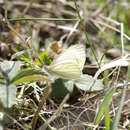Conservation Status
provided by University of Alberta Museums
Not of concern.
- license
- cc-by-nc
- copyright
- University of Alberta Museums
Cyclicity
provided by University of Alberta Museums
Two broods, flying in June and again in late July to August.
- license
- cc-by-nc
- copyright
- University of Alberta Museums
Distribution
provided by University of Alberta Museums
Found throughout Canada from Newfoundland west to the western Northwest Territories, and in the northeastern United States (Opler 1999). In Alberta, this species is restricted to the boreal and foothills region (Bird et al. 1995). There is an outlying population in the Cypress Hills of Saskatchewan, but it has not been found on the Alberta side (Layberry et al. 1998).
- license
- cc-by-nc
- copyright
- University of Alberta Museums
General Description
provided by University of Alberta Museums
This species and the Margined White (P. marginalis) are very similar. The Mustard White has well-marked, narrow and dark green markings along the veins of the hindwing underside, not broad, diffuse, and greyish-green as in marginalis. The second (summer) brood of oleracea often has these markings faint or absent. These two species occur together only in the foothills region. Alberta populations are the nominate subspecies (Layberry et al. 1998).
- license
- cc-by-nc
- copyright
- University of Alberta Museums
Habitat
provided by University of Alberta Museums
Moist mixed-wood forest.
- license
- cc-by-nc
- copyright
- University of Alberta Museums
Life Cycle
provided by University of Alberta Museums
The eggs are conical and yellow, with longitudinal ridges. Mature larvae are green with a dark dorsal stripe and numerous blacks dots. They are covered with short, dense hairs (Guppy & Shepard 2001). Pupae have dorsal and apical projections, and vary in colour from pale green to white to brown (Guppy & Shepard 2001).
- license
- cc-by-nc
- copyright
- University of Alberta Museums
Trophic Strategy
provided by University of Alberta Museums
The larval hostplants are unknown in Alberta. In BC, Mustard Whites feed on wild mustards (Brassicaceae) such as rock cress (Arabis spp.) (Guppy & Shepard 2001). In the right habitat, females will also lay eggs on cultivated mustards such as cabbage (Hooper 1973). Adults will also nectar at flowers of mustards (Nielsen 1999).
- license
- cc-by-nc
- copyright
- University of Alberta Museums

